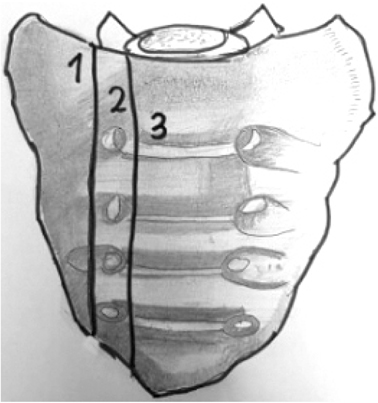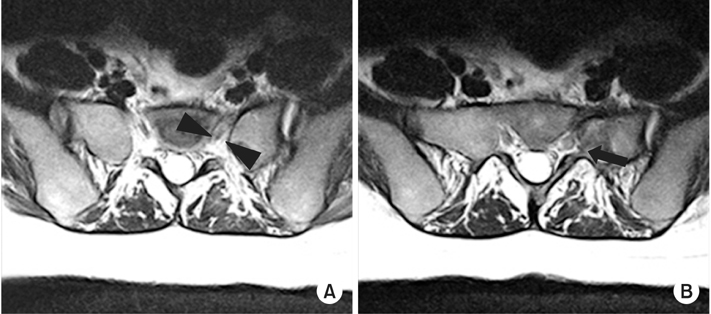J Korean Fract Soc.
2017 Jan;30(1):24-28. 10.12671/jkfs.2017.30.1.24.
Decompressive Sacral Foraminotomy for Nerve Root Injury during Conservative Treatment of Sacral Fracture: A Case Report
- Affiliations
-
- 1Department of Orthopedic Surgery, Kangdong Sacred Heart Hospital, Hallym University College of Medicine, Seoul, Korea. jshin2100@gmail.com
- 2Department of Orthopaedic Surgery, Hallym University Sacred Heart Hospital, Hallym University College of Medicine, Anyang, Korea.
- KMID: 2367349
- DOI: http://doi.org/10.12671/jkfs.2017.30.1.24
Abstract
- A 35-year-old woman visited the emergency department for a pedestrian traffic accident. Severe tenderness was noted at the posterior sacrum area, without open wound or initial neurologic deficit. Fracture of the left sacral ala extended to the S1 foramen, anterior acetabulum, and pubic ramus. Two weeks after the injury, she presented aggravating radiculopathy with the weakness of the left great toe plantar flexion. The S1 nerve root was compressed by the fracture fragments in the left S1 foramen. Decompressive S1 foraminotomy was performed. The postoperative follow-up computed tomography scan showed successful decompression of the encroachment, and the patient recovered well from the radiculopathy with motor weakness. She was able to resume her daily routine activity. We suggest that early decompressive sacral foraminotomy could be a useful additional procedure in selective sacral zone II fractures that are accompanied by radiculopathy with a motor deficit.
Keyword
MeSH Terms
Figure
Reference
-
1. Denis F, Davis S, Comfort T. Sacral fractures: an important problem Retrospective analysis of 236 cases. Clin Orthop Relat Res. 1988; 227:67–81.2. Young JW, Burgess AR, Brumback RJ, Poka A. Lateral compression fractures of the pelvis: the importance of plain radiographs in the diagnosis and surgical management. Skeletal Radiol. 1986; 15:103–109.
Article3. Kim MY, Reidy DP, Nolan PC, Finkelstein JA. Transverse sacral fractures: case series and literature review. Can J Surg. 2001; 44:359–363.4. Hersche O, Isler B, Aebi M. Follow-up and prognosis of neurologic sequelae of pelvic ring fractures with involvement of the sacrum and/or the iliosacral joint. Unfallchirurg. 1993; 96:311–318.5. Roy-Camille R, Saillant G, Gagna G, Mazel C. Transverse fracture of the upper sacrum. Suicidal jumpers fracture. Spine (Phila Pa 1976). 1985; 10:838–845.6. Schnaid E, Eisenstein SM, Drummond-Webb J. Delayed posttraumatic cauda equina compression syndrome. J Trauma. 1985; 25:1099–1101.7. Schmidek HH, Smith DA, Kristiansen TK. Sacral fractures. Neurosurgery. 1984; 15:735–746.
Article8. Fountain SS, Hamilton RD, Jameson RM. Transverse fractures of the sacrum A report of six cases. J Bone Joint Surg Am. 1977; 59:486–489.
Article9. Phelan ST, Jones DA, Bishay M. Conservative management of transverse fractures of the sacrum with neurological features A report of four cases. J Bone Joint Surg Br. 1991; 73:969–971.
Article10. Zelle BA, Gruen GS, Hunt T, Speth SR. Sacral fractures with neurological injury: is early decompression beneficial? Int Orthop. 2004; 28:244–251.
Article
- Full Text Links
- Actions
-
Cited
- CITED
-
- Close
- Share
- Similar articles
-
- Sacral Nerve Stimulation Through the Sacral Hiatus
- Usefulness of Kyphoplasty in Sacral Insufficiency Fracture: A Case Report
- A Case of Surgically Treated Transverse Sacral Fracture: A Case Report
- A Case of S1 Radiculopathy in Sacral Insufficiency Fracture without Fracture Line
- A Case of Surgically Treated by Transperitoneal Approach in Delayed Neurological Deficit after Sacral Fracture: A Case Report






